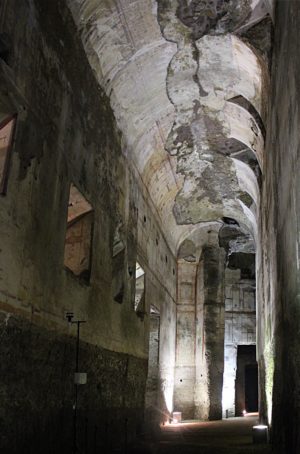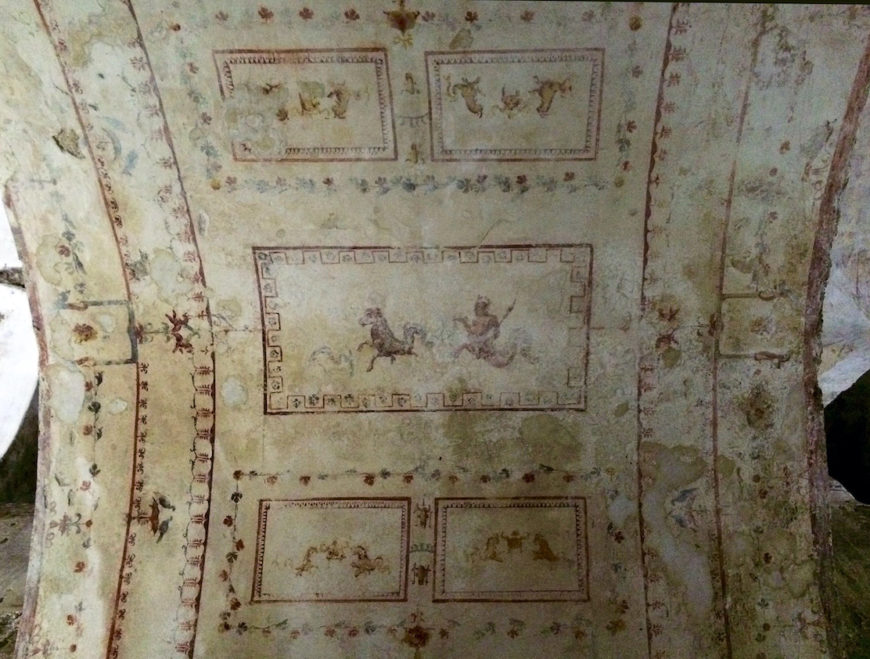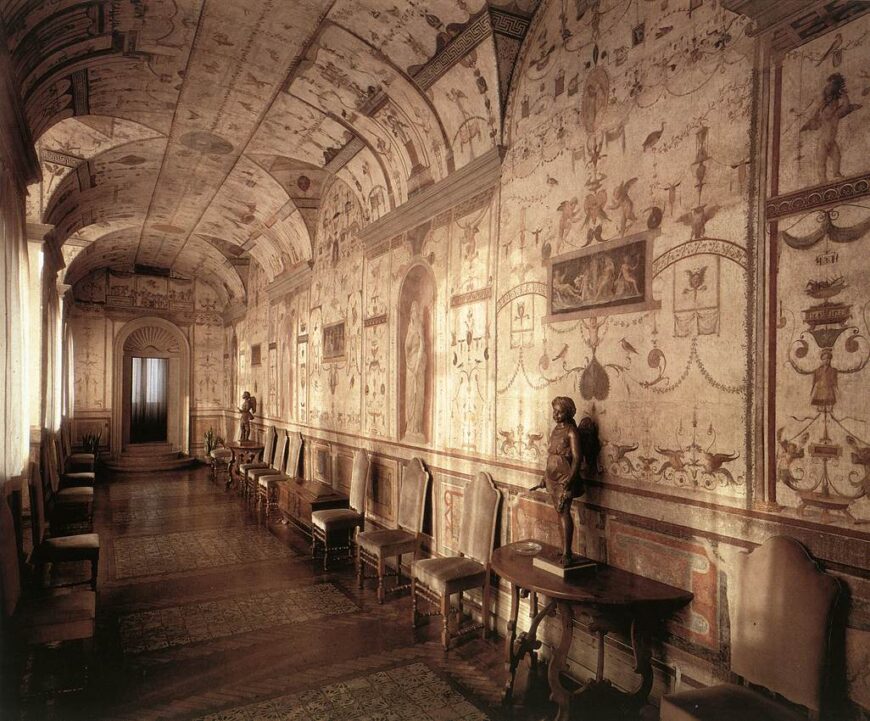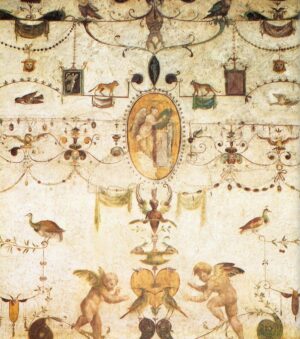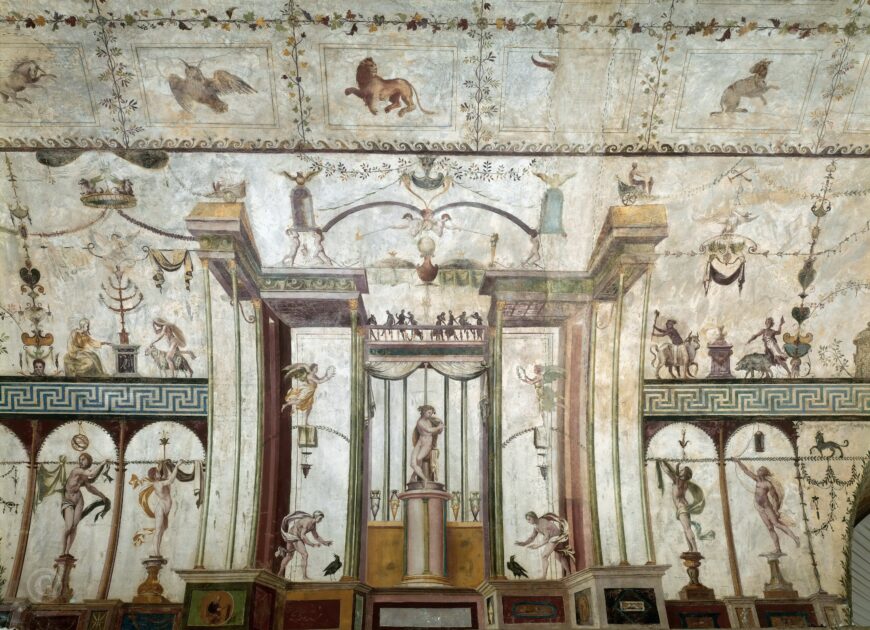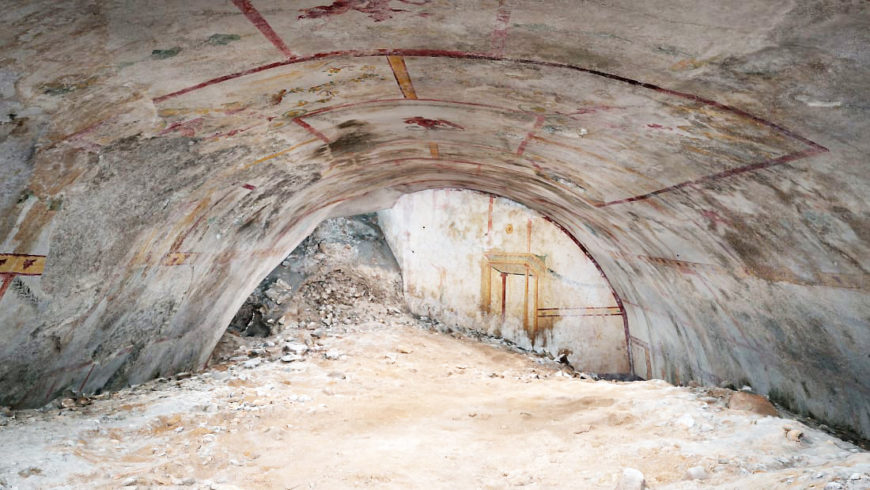
“Chamber Of The Sphinx,” rediscovered in 2019, Domus Aurea, Rome (photo: Parco archeologico del Colosseo)
Rediscovery
The air was frigidly cold, and the space narrow, low, and dirty. It was also completely dark except for the torchlight that made fantastical creatures come alive on the walls. These are the conditions under which the luxurious palace of the ancient Roman Emperor Nero (known in Latin as the Domus Aurea, or Golden Palace) was explored during the Renaissance. Beginning in the 1480s, more than a millennium after it was built, explorers crawled through the rooms. This was often painful, and yet also incredibly exciting, and visitors would often bring food with them to picnic in the depths of the structure. We can still get a sense of the high ground level they experienced as they crawled through these spaces thanks to a portion of the palace discovered in 2019, the so-called “Chamber of the Sphinx.”
The Domus Aurea once contained 300 rooms, grand gardens, an artificial lake, and even a rotating dining room. The palace complex spanned at least 50 hectares (123 acres) in the heart of the city of Rome. Though it was the most opulent imperial place constructed at that time, much of it was destroyed when the emperor Nero’s suicide resulted in a year of chaos before the Flavian emperors seized control and restored stability. At that time, the upper levels of Nero’s palace were destroyed and the lower levels were filled with earth. The abandoned palace later became the foundation for Baths built by the Emperor Trajan. It was these earth-filled rooms that people would crawl through.
Legend has it that the remains of the palace were discovered by a young boy who fell into what he described as painted caves. Though it is unknown who exactly was the first to start properly exploring this space, it quickly drew the attention of many notable Italian figures from the 15th and 16th centuries, including Michelangelo, Raphael and his apprentice Giovanni da Udine, painter Domenico Ghirlandaio, and author Casanova, among others. Many of these visitors carved their names into the walls and ceilings, making it easy to identify some of the explorers.
Initially, this structure was misidentified as the “Palace of Titus;” it is adjacent to the Bath complex built by Emperor Titus (78–80 C.E.). Raphael is often credited for correctly identifying the complex after he visited in 1514.
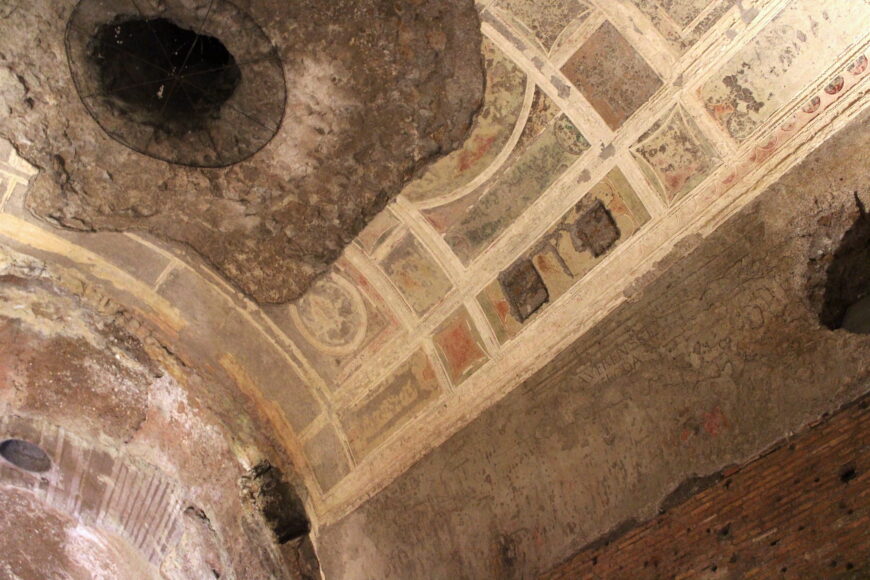
Holes from Renaissance explorers in the ceiling of the “Golden Vault” and graffiti with Renaissance explorers’ names. Domus Aurea, Rome, 65–68 C.E. (photo: Jessica Mingoia, CC BY-NC-ND 2.0)
Explorers in the 15th and 16th centuries traveled through what seemed at the time like a labyrinth of rooms and corridors. In some places, the debris was so high that they tunneled through walls to access other rooms, causing extensive damage along the way. Because there was no known entrance into the structure at the time, tunnels were cut through vaulted ceilings, damaging the ancient structure. Visitors would then lower themselves through the ceiling using ropes and pulleys. These holes are still recognizable in the ceilings today, such as in the so-called “Golden Vault,” which was one of the most popular rooms to visit. The cryptoporticus, or long vaulted passageway, was another frequently visited area.
Emergence of the grotesque
When the palace was discovered, most of the walls were hidden below ground, but explorers were able to get up close and personal with the ceilings. Because the painted vaulting had been cut off from air for so long, the frescoes and stuccoed ceiling designs were incredibly well preserved. The buried Domus Aurea was, of course, pitch black. The torches visitors carried made everything seem strange and mysterious and made the fantastical creatures in the wall paintings surrounding them appear to come alive. Because of this, the structure was quickly labeled a grotto, and it is from this term that grotesque is derived. Today we use the term “grotesque” to refer to a style of art featuring fanciful, ugly, bizarre, and/or mythical creatures or human forms of the sort found painted in the Domus Aurea.
The frescoes of the Domus Aurea fall under what we now call the Fourth style of Roman wall painting, which became popular in the mid-1st century C.E. around the time that the palace was constructed. This was the most eclectic of the Roman wall painting styles, incorporating everything from thin colonettes, garlands, and candelabra, to mythical animals and creatures.
The walls and ceiling were divided into separate panels, sometimes bordered by architectural frames and at other times by delicate floral frames. Figures were often free-floating in the central space of these panels. Very little ancient painting was known prior to the rediscovery of this building, so it was especially fascinating to the people of Renaissance Rome. While there was great interest in unearthing ancient sculptures throughout the city (which quickly became part of wealthy families’ private collections), these typically no longer retained their once vibrant polychromy, so the vivid compositions of the palace were particularly intriguing.
Starting during the Italian Renaissance, artists imitated the grotesque motifs, figures, and framing devices found on the ancient walls of the Domus Aurea with compositions often containing candelabras, acanthus tendrils, and mythical creatures. These were not identical replications but rather new works heavily influenced by the frescoes discovered in the ancient palace. This was directly related to the fascination at the time with producing works all’antica, meaning “in the style of antiquity”, an Italian term applied to works that revived and incorporated the styles of ancient Rome. The grotesque was just one of the ways artists emulated the characteristics of classical antiquity.
Though this began in Italy, thanks to trade and colonization, the all’antica spread over time becoming a global phenomenon. While these grotesque motifs (grotteschi) appeared in a variety of works of art, two Italian Renaissance examples in particular are especially notable for their similarities to the Domus Aurea.
The Stufetta of Cardinal Bibbiena
The impact of the Domus Aurea frescos can be seen first in The Stufetta of Cardinal Bibbiena, constructed in the Apostolic Palace of the Vatican in 1516. This was the first time that grotesque forms were used to decorate an entire room since antiquity. The Cardinal was a lifelong supporter of the arts and friends with Raphael, who designed the stufetta, or warm bathing room. Raphael’s pupil, Giovanni da Udine, also had a hand in the design and execution of the washroom.
Initially, Raphael was not drawn to the Domus Aurea. However, Giovanni da Udine convinced Raphael to visit the structure in 1514 and eventually take up grotesque forms himself. Giovanni, who was especially fascinated with the Domus Aurea and the techniques of the ancients, succeeded in recreating the ancient Roman technique for stucco, using white travertine, lime, and powdered white marble.
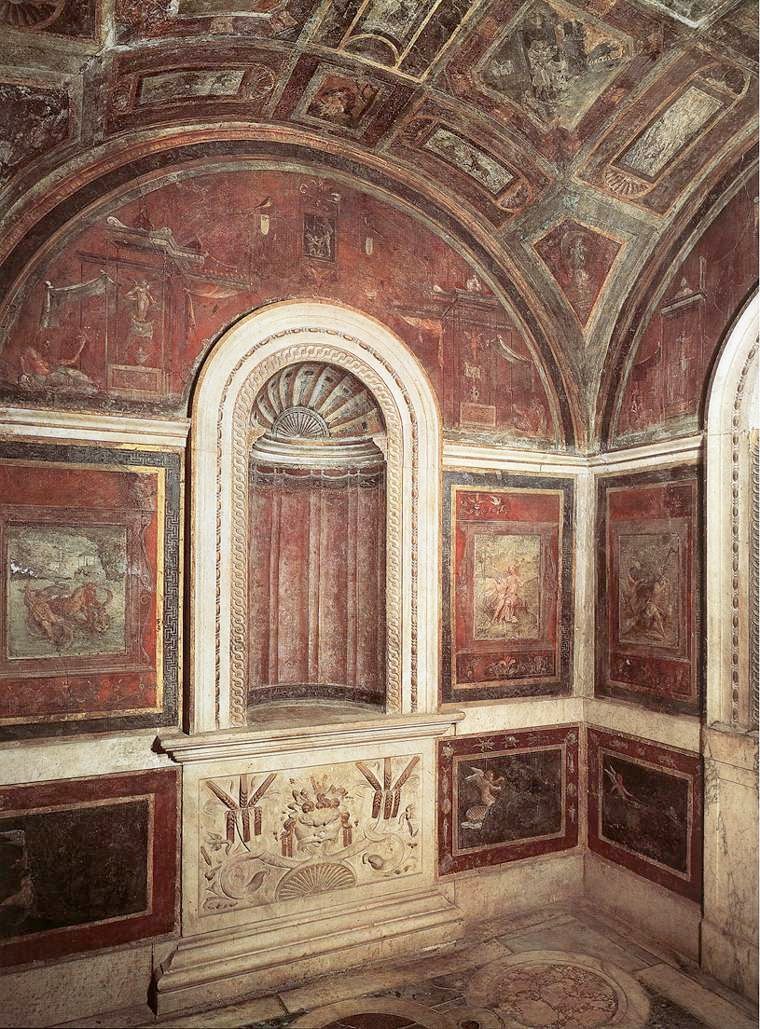
Arcuated niche, Stufetta of Cardinal Bibbiena, 1516, fresco (Apostolic Palace in the Vatican, public domain)
The main color used throughout the Stufetta of Cardinal Bibbiena is red, a color used more sparingly in the Domus Aurea. Though no one yet knew it at this time, this particular shade of red (comprised of a red ochre with high iron oxide content), would later be found in abundance in the ancient cities of Pompeii and Herculaneum, eventually earning it the name “Pompeiian Red.”
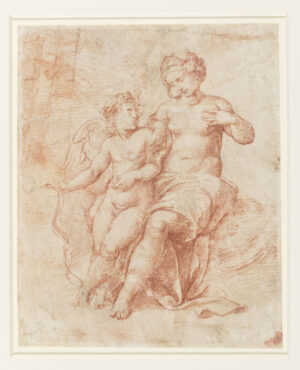
This corresponds to a fresco in the Stufetta. Attributed to Giulio Romano, Venus and Cupid, red chalk over stylus underdrawing, 21.1 x 17.2 cm (Royal Collection Trust)
As in the paintings of the Domus Aurea, the walls were divided into separate panels by architectural frames or delicate garlands. Some frames depict mythological scenes from Ovid while others feature free-floating grotesques.
Despite being constructed for a Catholic Cardinal at the Vatican, the room was filled with erotic, pagan imagery. There are playful nymphs and satyrs, aroused and nude mythological figures, and multiple details from the life of Venus, the Roman goddess of love, including her birth and a later image of her with Cupid and dolphins. Other panels include winged putti and mythological creatures interspersed with real animals and other pagan deities.
Cardinal Bibbiena, who was also a risqué playwright, chose to emulate these sensual and sometimes bawdy images without censorship. Even in the context of the Vatican, erotic grotteschi appear because these images help emulate the all’antica, that desire to imitate the style of the ancient Romans as closely as possible. However, these images were still relegated to a private bathroom and not on public view. Despite this, many of the more salacious images were destroyed or replaced in later eras.
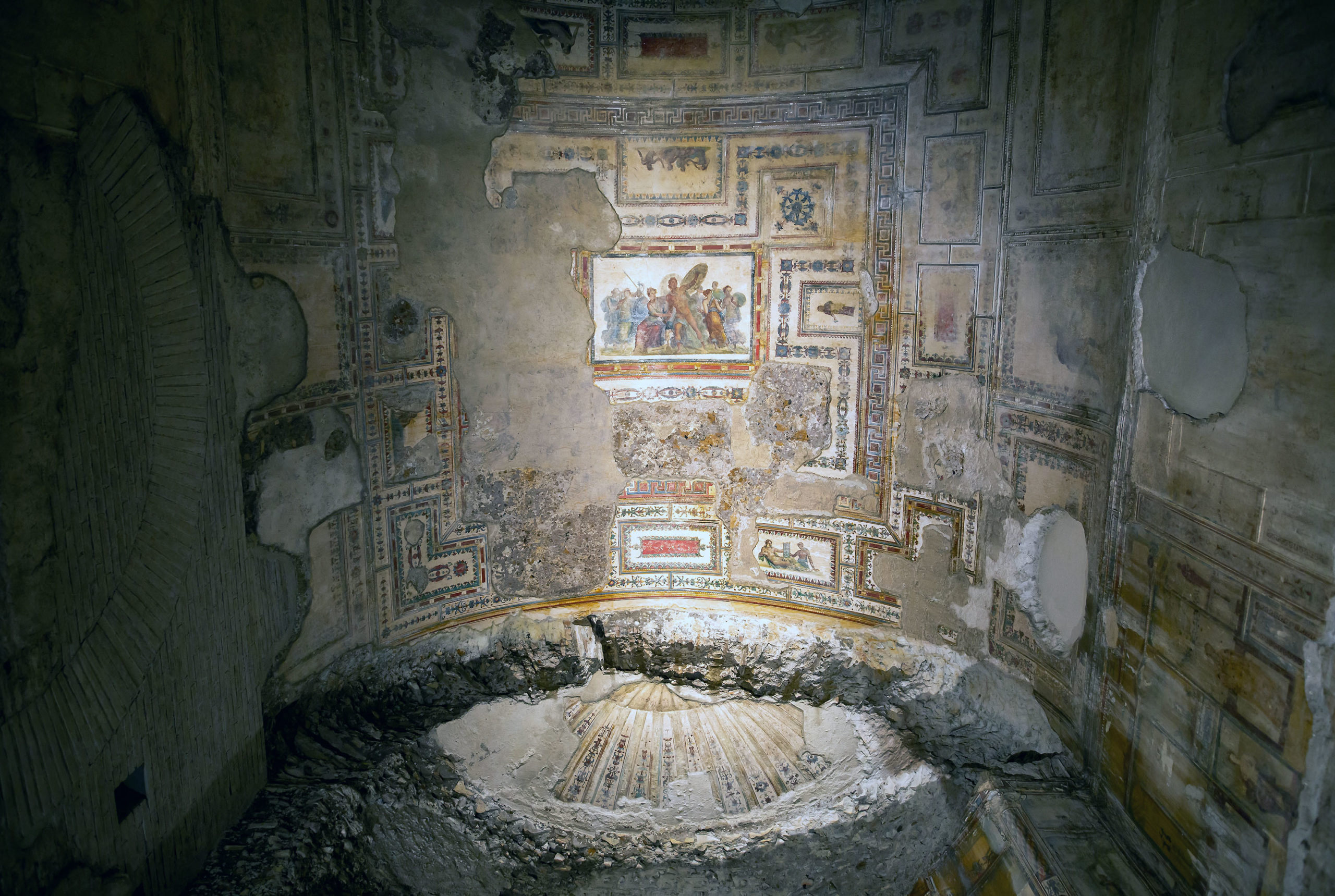
Overhead view of stuccoed and painted vaulting, “Hall of Achilles,” Domus Aurea, 65–68 C.E. © ERCO GmbH
Frescoes continue on the ceiling. The back wall contained an arcuated (arched) niche shaped like a seashell, which was often used in Roman architecture in apses and niches, especially grottos, fountains, and other water features. A similar, but much larger, seashell shaped apse ceiling was found in one of the rooms of the Domus Aurea, the so-called Hall of Achilles, a room explored in the Renaissance.
The Loggetta of Cardinal Bibbiena
One year later, in 1517, Raphael and Giovanni created the frescoes for Cardinal Bibbiena’s Loggetta, or loggia, which is a covered corridor also located in the Apostolic Palace at the Vatican. Raphael is credited with the overall design while Giovanni is responsible for working on individual motifs. This corridor, in particular, imitated the cryptoporticus (long, covered hallway) of the Domus Aurea. Just like in the ancient structure, the walls and vaults are covered with frescoes divided into separate panels each containing a candelabra, grotesque, or other free-floating figures framed by delicate colonettes. Garlands and plant tendrils connect the framing devices to the grotesques in the middle. Despite the varied nature of the motifs within the fresco, it is well organized and symmetrical.
As with the cryptoporticus, the dominant wall color of the Loggetta is white. It also features a groin vault, as in the Domus Aurea, and each section of the vault contains a different vignette from the myths of the Greek god Apollo. One side of the Loggetta featured three windows which allow natural light to flood the passageway. At each end of the corridor is a doorway, above which is a seashell, also derived from what was seen in the Domus Aurea. Even in a space as light as the Loggetta, the seashell motif hearkens back to the concept of a grotto.
Unlike the Stufetta which contained only pagan images, the Loggetta contained a mix of grotesque and pagan figures combined with motifs from the Bible. There are a series of narrative scenes from both the Old and New Testament across the vaults, including the creation, the burning bush, and the Last Supper. The Loggetta seamlessly blends Christian imagery with grotesque beasts, delicate foliage, decorative candelabra, and real animals, like birds, snails, and mice. Though it may sound as if these motifs do not belong together, this space epitomizes how the grotesque could appear integrated alongside Christian religious imagery in a private context. The appropriateness (or lack thereof) of this iconographical pairing would receive much debate over the next two centuries.
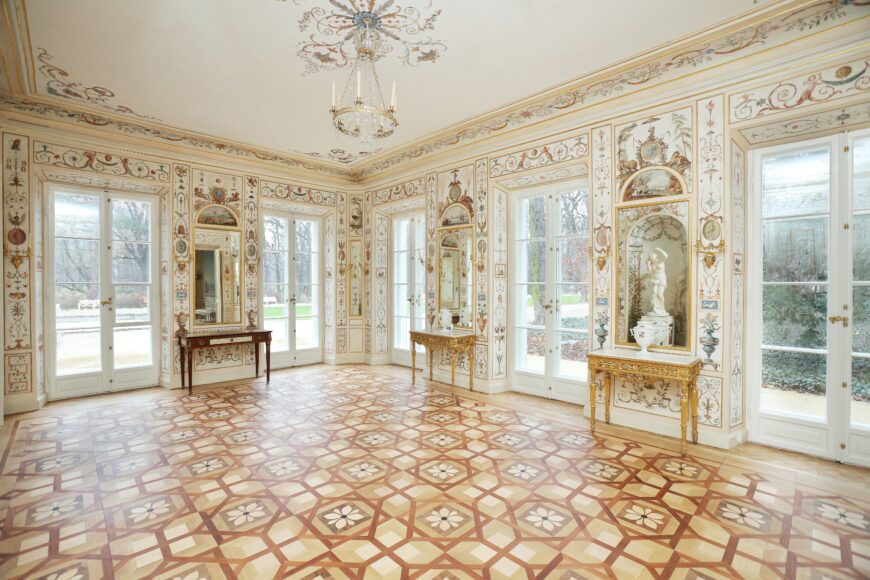
The grotesques depict various figures, including symbols of the Four Continents, the Four Elements, the Four Seasons of the Year, the Zodiac Signs, as well as representations of various occupations, such as the work on the land, the gardening and also play. The Dining Room, Eating Room, Arabesque Room in the White Pavilion, Warsaw (The Royal Łazienki Museum in Warsaw)
The legacy of the Domus Aurea
Grotesque forms revived an appealing ancient heritage, but also offered a novel form of decorative expression. For Renaissance artists and collectors fascinated with anything ancient Roman, the rediscovery of the Domus Aurea was like striking gold. Until the rediscovery of Pompeii and Herculaneum in the 18th century, this was the largest assemblage of ancient Roman paintings that had been found.
The visual influence of the Domus Aurea was profound. Many of the painting motifs from the Domus Aurea would continue to appear in other artistic movements including Neoclassicism centuries later. Swirling plant tendrils and thin colonettes would not only make their way into other types of Renaissance paintings and engravings, but also frequently appear as a wallpaper motif in Neoclassical houses. With its grotto-like hallways and rooms, vibrant polychromy, mythical creatures, and fanciful vegetal motifs, the Domus Aurea captured the imagination of artists for centuries, making it as one of the most influential ancient Roman structures in the history of art.
Additional resources
Larry F. Ball, The Domus Aurea and the Roman Architectural Revolution (New York: Cambridge University Press, 2003).
Leonard Barkan, Unearthing the Past: Archaeology and Aesthetics in the Making of Renaissance Culture (New Haven: Yale University Press, 2000).
Marco Brunetti, “Tendaggi dipindi: Le volte a padiglione della Domus Aurea e riusi nell’arte di Raffaello,” Accademia Raffaelo—Atti e studi 20 (2021): pp. 19–60.
Jill Burke, ed., Rethinking the High Renaissance: The Culture of the Visual Arts in Early Sixteenth-Century Rome (Visual Culture in Early Modernity) (New York: Routledge, 2016).
Nicole Dacos, La découverte de la Domus Aurea et la formation des grotesques à la Renaissance (Leiden: E.J. Brill, 1969).
Nicole Dacos, “Les loges de Raphaël: répetoire à l’antique, Bible et mythologie,” in Classical Influences on European Culture AD 1500–1700: Proceedings of an International Conference held at King’s College, Cambridge, April 1974, edited by R.R. Bolgar (Cambridge: Cambridge University Press, 1976), pp. 325–34.
Nicole Dacos, “Per la Storia delle Grottesche. La Riscoperta della Domus Aurea,” Bollettino d’Arte 51 (1996): pp. 43–49.
Nicole Dacos, The Loggia of Raphael: A Vatican Art Treasure, translated by J. Bacon (New York: Abbeville Press, 2008).
Geoffrey Galt Harpham, On the Grotesque: Strategies of Contradiction in Art and Literature (Princeton: Princeton University Press, 1982).
Philippe Morel, Les Grotesques. Les figures de l’imagination dans la peinture italienne de la fin de la Renaissance (Paris: Flammarion, 1997).
Michael Squire, “Fantasies so Varied and Bizarre: The Domus Aurea, the Renaissance, and the Grotesque,” in The Blackwell Companion to the Age of Nero, edited by M. Dinter and E. Buckley (Malden, MA: Wiley-Blackwell, 2012), pp. 444–464.
Yves Perrin, “Ȇtres mythiques, fantastiques et grotesques dans la Domus Aurea,” Dialogues d’histoire Ancienne 8 (1982): pp. 303–338.
G. C. Picard, “Les ‘grotesques’ de la maison d’or de Néron à Rome,” Archéologia 86 (1984): pp. 56–71.
Diocletio Redig de Campos, “La Stufetta del Cardinal Bibbiena in Vaticano e il suo restauro,” Rӧmisches Jarbuch für Kunstgeschichte 20 (1983): pp. 221–240.
Maren Elisabeth Schwab & Anthony Grafton, The Art of Discovery: Digging into the Past in Renaissance Europe (Princeton: Princeton University Press, 2022).
Roberto Weiss, The Renaissance Discovery of Classical Antiquity (Oxford: Humanities Press, 1969).
Alessandra Zamperini, Ornament and the Grotesque: Fantastical Decoration from Antiquity to Art Nouveau (London; New York, NY: Thames & Hudson, 2008).

